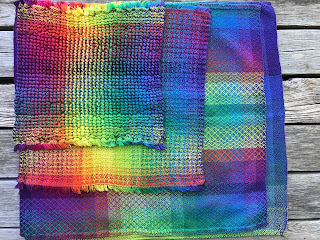I love playing with pick-up sticks, and I love the magic of inlay in all of its many variations (and there are many!). For Rigid Heddle weavers, it's a relatively painless way to put geometric patterns and even more complex images into our woven projects - often only needing a pick-up stick (though sometimes multiple heddles are needed).
I've been having trouble finding a definitive definition of inlay, but Betty Linn Davenport has a pretty good one in her book Hands on Rigid Heddle Weaving. To summarize, I've made a list of the characteristics that inlay usually exhibits:
Supplemental weft (maybe also supplemental warp?)
Discontinuous thread (usually doesn't go all the way from selvedge to selvedge)
Plain weave ground, usually (though twill is also used in multi-shaft weaving)
Woven in (not added later like embroidery)
Usually a heavier thread than the ground weft and the warp
Usually in a contrasting color/colors
Can be on a balanced weave or on a weft-faced weave
It includes:
Simple inlay, laid-in patterning, wrapped inlay, inlay with cut wefts, Theo Moorman technique, transparency, brocade, Swedish Krabba and Dukagång, Bhutanese Kushutara, Kutch supplemental weft patterns, and many other gorgeous ethnic and world fabric techniques for which I do not know the names.
It probably also includes looped, twined, and knotted textural supplemental weft techniques like Boutonné, Flossa/Rya/Ghiordes knots, Soumak, and probably other techniques I’ve yet to discover!
And here are some resources that have inlay info and drafts and projects.
1. Books that Heddlers might have:
- Davenport, Betty Linn, Hands on Rigid Heddle Weaving, Interweave Press, 1987, pgs. 61-68.
- Davenport, Betty Linn, Textures and Patterns for the Rigid Heddle Loom, Revised Edition, 2008, pgs.19-25
- Mitchell, Syne, Inventive Weaving on a Little Loom, Storey Publishing, 2015, pgs.73-181, 212-215.
- Patrick, Jane, The Weaver’s Idea Book: Creative Cloth on a Rigid-Heddle Loom, Interweave Press, 2010, pgs. 108-113, 141-160.
2. And other important weaving books that have inlay info:
- Black, Mary E., New Key to Weaving, Macmillan Publishing Company, 1957 edition, pgs. 98-104, 117-147.
- Dixon, Anne, The Handweaver's Pattern Directory, Interweave Press, 2007, pgs. 238-241.
I haven't really explored my magazines yet, but the Handwoven magazine March/April 2017 is all about Scandinavian weaving - for inlay, try pages 14-15, 48-50, and 56-57.
Eye Candy:
Warped for GoodThis is my sampler from a Joanna Hall class on Swedish Art Weaves - some done in class, some done later on my own. From bottom to top, has Krabba, Rolokan, Halvkrabba, Monks Belt, Dukagång, more Halvkrabba, and more Krabba (playing with a larger scale on this one, to see if the floats are still manageable).
Not all of these rows are inlay. Rolokan is not an inlay - though it is a discontinuous weft, its wefts form part of the ground structure and so they are not supplemental wefts ( Rolokan is a tapestry weaving technique).
Can Monks Belt be considered inlay? I don't know. In this sampler, it uses a discontinuous weft pattern that does float over the plain weave ground like the other inlays, so maybe?
Sampler is weft faced, uses Borgs Faro single ply wool weft and Bockens 16/3 linen warp sett at 10 epi. And a pick-up stick. And the occasional heddle stick (for Monks Belt and Dukagång)











